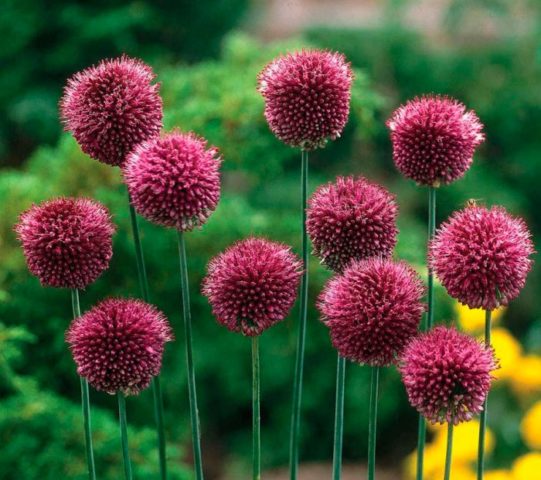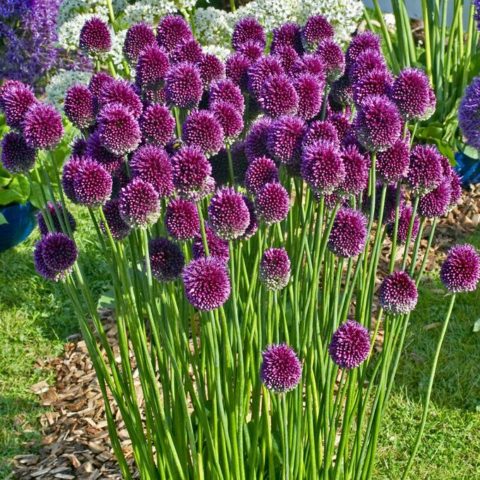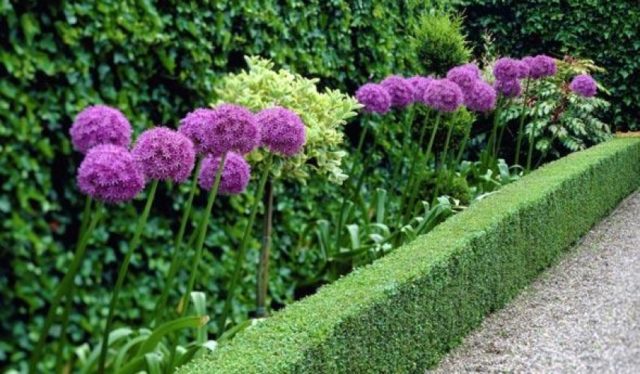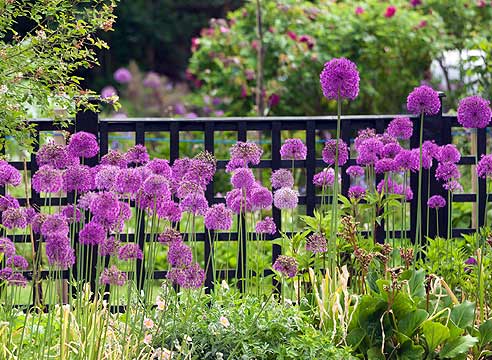Content
Allium round-headed is a perennial decorative onion with original spherical flowers of a pale purple color. The plant is distinguished by its unpretentiousness and good winter hardiness. It does not need abundant watering, since it tolerates drought well. Allium can be grown from both bulbs and seeds.
Description
Round-headed Allium is a decorative bow that looks more like the original flower of pale purple, pink and lilac shades. It is a perennial, rather tall herb (up to 50 cm) with large spherical flowers (up to 8 cm in diameter). Flowering begins in late June and lasts 2-3 weeks. The flowers exude scent and decorate the garden. If you rub the leaves, you will get a garlic smell.

Allium round-headed flowers attract attention due to their unusual shape and pleasant light purple color
This variety is distinguished by its unpretentiousness and good winter hardiness, due to which it can be grown both in the Central part of Russia and in other regions (Ural, Siberia, Far East).
They can be immediately covered with other decorative plants, for example, ground cover, grass.
Growing from seeds
Allium can be grown independently from seeds. They are planted in the spring, when the snow has melted, and frosts are not expected, or in the fall a month before the temperature drops. Germination is not very high, in order to raise it, it is necessary:
- soak the seeds in a solution of a growth stimulator (Epin, Kornevin) and others;
- plant more material than necessary. After that, make a pick.
Both in autumn and in spring planting, the seeds of allium round-headed are planted under a film, watered abundantly. The soil is pre-dug up and a complex mineral fertilizer is applied. After the appearance of sprouts 5-7 cm high, they are seated at a distance of 30-50 cm from each other.

Allium seeds can be harvested by yourself when the heads are completely withered and dry
How and when to plant in open ground
Allium roundhead can be planted with bulbs in spring or autumn. In the latter case, the plants will immediately receive frost hardening, which will allow them to take root better. If the deadline is missed, spring planting is also acceptable.
Site selection and preparation
When choosing a place, you should pay attention to several points:
- Decorative - round-headed allium looks good in open, illuminated spaces.
- Minimum moisture - ornamental onions do not grow in wetlands, in lowlands.
- No strong drafts.
It is better to prepare the site a few weeks before planting. To do this, you need to dig it up and add humus with wood ash or complex mineral fertilizer (50 g / m2).
Planting stages
The landing instructions are quite simple:
- Prepare several holes at a distance of 30-50 cm.They should be as deep as 3 diameters of the bulb.
- Lay the drainage layer - pebbles, brick chips.
- Mix garden soil with humus and compost (2: 1: 1), add a pinch of wood ash (if not added during digging).
- Plant the bulbs, lay down the soil and tamp it lightly.
- Water the beds with settled water and mulch the surface with torus, sawdust, hay or other materials at hand.
Care
Caring for allium round-headed is simple. Ornamental onions need regular, but not too abundant watering. The soil surface should remain only slightly damp. The plant tolerates short-term drought well, so even in the absence of rain, it is enough to water once a week. In order for the soil to retain moisture longer, it can be mulched with peat, pine needles, and straw.
Top dressing for the roundhead allium is applied several times per season:
- In the spring, when leaves and shoots begin to form, it is important to add any nitrogen-containing fertilizer.
- During the formation of buds and flowering, a complex mineral fertilizer or a mixture of superphosphates with potassium salt is applied.
- The same potassium-phosphate composition is fed in early September to prepare the plant for the winter season.
- If possible, then immediately before the onset of frost, the soil can be covered with peat and humus.

To achieve lush flowering, round-headed allium must be fed three times per season.
After watering and fertilizing, the soil must be loosened. Allium roundhead prefers light soil saturated with oxygen. In this case, nutrients will quickly enter the plant tissues. You also need to periodically weed so that the weeds do not interfere with the onion growing normally.
Diseases and pests
Allium roundhead, like other types of onions, has good immunity to diseases and pests. However, improper agricultural technology (excessive watering) can lead to damage by such diseases:
- neck rot;
- powdery mildew.
If the leaves of the plant began to turn yellow en masse, a powdery bloom appeared on them, it is necessary to treat the onion as soon as possible with any fungicide, for example: Bordeaux liquid, Skor, Fitosporin, Ordan, Maxim.
Of insects, the onion fly and root mite can bring the greatest harm to the round-headed allium. To combat them, plants can be sprayed with any insecticide. To do this, use Karbofos, Chlorofos, Fitoverm, Aktara and others.
Reproduction
Most often, roundhead allium is propagated by dividing the mother bush, which is 3-4 years old. To do this, in the fall, the bulbs are manually separated from the mother, and then planted in a permanent place. Along with daughter bulbs, you can also use the mother.
Another breeding method is by bulbs. This is the name of the small bulbs that appear after flowering ends. They are also planted in the fall, after holding them for several hours in a solution that stimulates root formation.
Photo in landscape design
Allium roundhead looks very beautiful thanks to its lush lilac flowers. It can be used in different ways: single planting, alpine slides, planting along paths, in an open, illuminated place (well-groomed lawn), rabatki.

Allium roundhead is often planted along the paths

Multi-tiered compositions of decorative bows look unusual and are often used by designers.

Planting along a low fence will allow you to zone the flower garden

Using a dense planting of allium, you can create a hedge
Conclusion
Allium roundhead is easy enough to grow in the garden. If desired, ornamental onions can be cultivated even indoors by choosing a suitable pot with drainage holes. Decorative bow does not have any special requirements for care, so any gardener can breed it.








